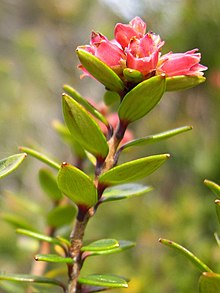| Archeria traversii | |
|---|---|

| |
| Scientific classification | |
| Kingdom: | Plantae |
| Clade: | Tracheophytes |
| Clade: | Angiosperms |
| Clade: | Eudicots |
| Clade: | Asterids |
| Order: | Ericales |
| Family: | Ericaceae |
| Genus: | Archeria |
| Species: | A. traversii |
| Binomial name | |
| Archeria traversii Hook.f. | |
Archeria traversii is a species of shrub in the family Ericaceae.
Distribution
Archeria traversii is scattered locally across southern New Zealand (the South Island and Stewart Island), where it is endemic. It is notably absent from Marlborough and much of the eastern South Island.
Ecology
It is largely found in shrublands and conifer-broadleaf forests, at lowland to montane altitudes. Flowering takes place from December to February, and fruiting from February to April.
Morphology
- Habit
- An erect shrub, up to 5 m tall but often much shorter. It has spreading to ascending branches, with leaves that are fairly evenly spaced (rather than clustered, like A. racemosa). Multiple trunks are often formed, and can be highly twisted, rough, and covered in epiphytic bryophytes. The bark is dark brown in colour, with branchlets that are light reddish when young and light brown when mature.
- Leaves
- Narrow lanceolate leaves, becoming glabrous and leathery. Dark green on the adaxial side, while abaxially they tend to be much paler. The leaf apices are acute to subacute, and sometimes reddish in colour. The base of the leaf is rigid and nearly sessile, attached to the stem with a short and flat petiole. Dimensions are roughly 7–12 mm long and 2–4 mm wide. Leaf margins are entire, minutely ciliolate, and flat to slightly recurved. Prominent venation can often be seen on the abaxial sides of the leaves (3- to 5-veined).
- Inflorescence
- A solitary terminal raceme, with 8–16 flowers, ranging from 10 to 30 mm in length. The axis and short curved pedicels are both pubescent. The bracts are oblong and caducous.
- Flowers & fruits
- The flowers are perfect, 4–5 mm long, urn shaped, with a corolla that is white to pink to deep red in colour (often lighter at the base and darkening towards the lobes). The sepals are oblong and ciliolate, frequently light green but turning to red towards the tips. Capsules are 2–3 mm in diameter, with 3–5 locules.
Evolutionary history
The phylogeny of the genus remains unknown, but morphologically A. traversii appears to most closely resemble A. racemosa, the only other New Zealand species in the genus.
Conservation status
Archeria traversii is currently regarded as non-threatened.
Etymology
Archeria was named by Joseph Dalton Hooker in 1844 after the nineteenth-century Tasmanian botanist W. Archer. The specific epithet traversii comes from William Travers, a 19th-century New Zealand naturalist and politician, after whom the plant species was named.
References
- "Archeria traversii Hook.f. | Plants of the World Online | Kew Science". Plants of the World Online. Retrieved 2020-01-18.
- ^ Allan, H.H. 1961. Flora of New Zealand. Volume I: Indigenous Tracheophyta - Psilopsida, Lycopsida, Filicopsida, Gymnospermae, Dicotyledons. Government Printer, Wellington.
- ^ Eagle, Audrey (2008). Eagle's complete trees and shrubs of New Zealand volume two. Wellington: Te Papa Press. p. 556. ISBN 9780909010089.
- ^ Smith-Dodsworth, J.C. 1991. New Zealand Native Shrubs and Climbers. David Bateman Ltd, Auckland.
- Dawson, J., Lucas, R. 2011. New Zealand's Native Trees. Craig Potton Publishing, Nelson.
- De Lange, P., Heenan, P., Norton, D., Rolfe, J., Sawyer, J. 2010. Threatened Plants of New Zealand. Canterbury University Press, Christchurch.
External links
- Flora of New Zealand
- Archeria traversii at the New Zealand Plant Conservation Network
- Archeria traversii at the Te Papa Collections Online